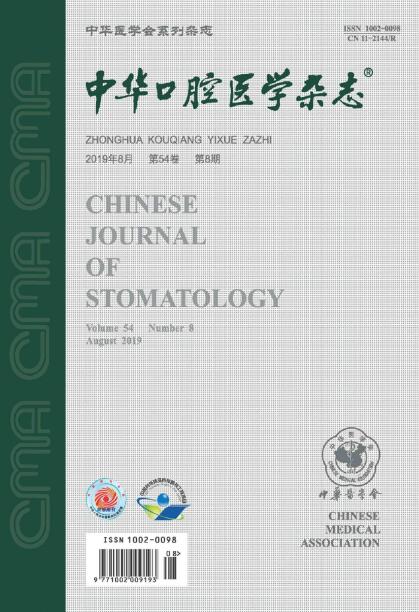南京市社区管理2型糖尿病患者牙周健康状况及相关因素分析
摘要
目的:了解南京地区2型糖尿病(T2DM)患者慢性牙周炎的患病率、严重程度及影响因素。方法:采用多阶段分层整群随机抽样方法,于2022年6月至8月,从国家T2DM健康管理基本公共卫生服务项目中抽取35岁及以上社区居住T2DM患者1 477例。进行了体格检查、实验室检查和问卷调查。研究对象分为慢性牙周炎组和非慢性牙周炎组。慢性牙周炎组定义为至少在两个非相邻部位检测到近端间临床附着缺失(CAL),或至少在两个探探深度(PD)≥3mm的部位检测到颊/舌牙附着缺失≥3mm,同时排除非牙周原因引起的CAL。其余的参与者被归类为非慢性牙周炎组。在慢性牙周炎组中,PD≥6 mm且至少两个部位CAL≥5 mm的患者被定义为重度牙周炎,其余病例被归类为轻中度牙周炎。结果:T2DM患者慢性牙周炎患病率为70.1%(962/1 373),轻中度和重度牙周炎患病率分别为62.4%(857/1 373)和7.6%(105/1 373)。经复杂加权处理后,T2DM患者慢性牙周炎患病率为67.9%,其中轻中度和重度牙周炎患病率分别为61.2%和6.7%。多因素logistic回归分析显示,调整所有协变量后,与脑力劳动者相比,退休人员(OR=1.78, 95%CI: 1.75 ~ 1.81, P0.001)、失业/其他人员(OR=2.18, 95%CI: 2.14 ~ 2.22, P0.001)和体力劳动者(OR=3.80, 95%CI: 3.73 ~ 3.87, P0.001)患慢性牙周炎的风险明显更高。在血糖控制情况方面,与两项控制指标均达到组相比,仅达到一项控制指标组(OR=1.28, 95%CI: 1.27 ~ 1.30, P0.001)和两项控制指标均未达到组(OR=3.29, 95%CI: 3.25 ~ 3.34)发生慢性牙周炎的风险显著高于两项控制指标均达到组(p < 0.001)。有序Logistic回归结果显示,在调整所有协变量后,与男性患者相比,女性患者进展为严重牙周炎的风险显著降低(OR=0.77, 95%CI: 0.76-0.78, P0.001)。在健康生活方式得分方面,与0 ~ 2分的患者相比,3分组(OR= 0.85, 95%CI: 0.84 ~ 0.86, P0.001)和4分组(OR=0.51, 95%CI: 0.50 ~ 0.52, P0.001)进展为严重牙周炎的风险显著降低。在血糖控制方面,与满足两个控制目标的组相比,仅满足一个目标的组(OR=1.27, 95%CI: 1.26-1.29, P0.001)和不满足两个目标的组(OR=3.24, 95%CI: 3.21-3.28, P0.001)进展为严重牙周炎的风险显著高于满足两个控制目标组(OR=3.24, 95%CI: 3.21-3.28, P0.001)。此外,血糖控制不良与牙周炎严重程度的增加显著正相关,表明血糖控制状况较差与牙周炎严重程度恶化的风险较高(P0.001)。结论:T2DM患者的血糖控制状况与慢性牙周炎有关。Objective: To investigate the prevalence, severity, and influencing factors of chronic periodontitis in patients with type 2 diabetes mellitus (T2DM) in Nanjing. Methods: From June to August 2022, by using a multi-stage stratified cluster random sampling method, a total of 1 477 community-dwelling T2DM patients aged 35 years and older were selected and included from the National Essential Public Health Services Program for T2DM health management. Physical examinations, laboratory tests, and questionnaire surveys were conducted. Study participants were divided into chronic periodontitis group and non-chronic periodontitis group. The chronic periodontitis group was defined as having interproximal clinical attachment loss (CAL) detected at least at two non-adjacent sites, or having buccal/lingual CAL≥3 mm at least at two sites with probing depth (PD)≥3 mm, while excluding CAL caused by non-periodontal reasons. The remaining participants were classified as the non-chronic periodontitis group. In the chronic periodontitis group, patients who had PD≥6 mm at least at two sites with CAL≥5 mm were defined as severe periodontitis, with remaining cases classified as mild-to-moderate periodontitis. Results: The prevalence of chronic periodontitis among T2DM patients was 70.1% (962/1 373), with mild to moderate and severe periodontitis prevalence rates of 62.4% (857/1 373) and 7.6% (105/1 373), respectively. After complex weighted processing, the prevalence of chronic periodontitis in T2DM patients was 67.9%, with mild to moderate and severe periodontitis prevalence rates of 61.2% and 6.7%, respectively. Multivariate logistic regression analysis showed that after adjusting all covariates, compared with mental workers, the risk of chronic periodontitis was significantly higher in retired people (OR=1.78, 95%CI: 1.75-1.81, P<0.001), unemployed/others (OR=2.18, 95%CI: 2.14-2.22, P<0.001), and physical workers (OR=3.80, 95%CI: 3.73-3.87, P<0.001). In terms of blood glucose control status, compared with the group that met both control targets, the risk of chronic periodontitis was significantly higher in the group that met only one target (OR=1.28, 95%CI: 1.27-1.30, P<0.001) and the group that met neither target (OR=3.29, 95%CI: 3.25-3.34) (P<0.001). The results of ordered Logistic regression showed that after adjusting for all covariates, compared with male patients, female patients had a significantly lower risk of progression to severe periodontitis (OR=0.77, 95%CI: 0.76-0.78, P<0.001). In terms of the score of healthy lifestyle, compared with those with a score of 0-2, the risk of progression to severe periodontitis was significantly lower in those with a score of 3 (OR=0.85, 95%CI: 0.84-0.86, P<0.001) and 4 (OR=0.51, 95%CI: 0.50-0.52, P<0.001). In terms of blood glucose control, compared with the group that met both control targets, the risk of progression to severe periodontitis was significantly higher in the group that met only one target (OR=1.27, 95%CI: 1.26-1.29, P<0.001) and the group that meet neither target (OR=3.24, 95%CI: 3.21-3.28, P<0.001). Furthermore, poor blood glucose control was significantly positively associated with increased periodontitis severity, demonstrating that worse glycemic control status corresponded to a higher risk of worsening periodontitis severity (P<0.001). Conclusions: There is an association between the glycemic control status of T2DM patients and chronic periodontitis.

 求助内容:
求助内容: 应助结果提醒方式:
应助结果提醒方式:


